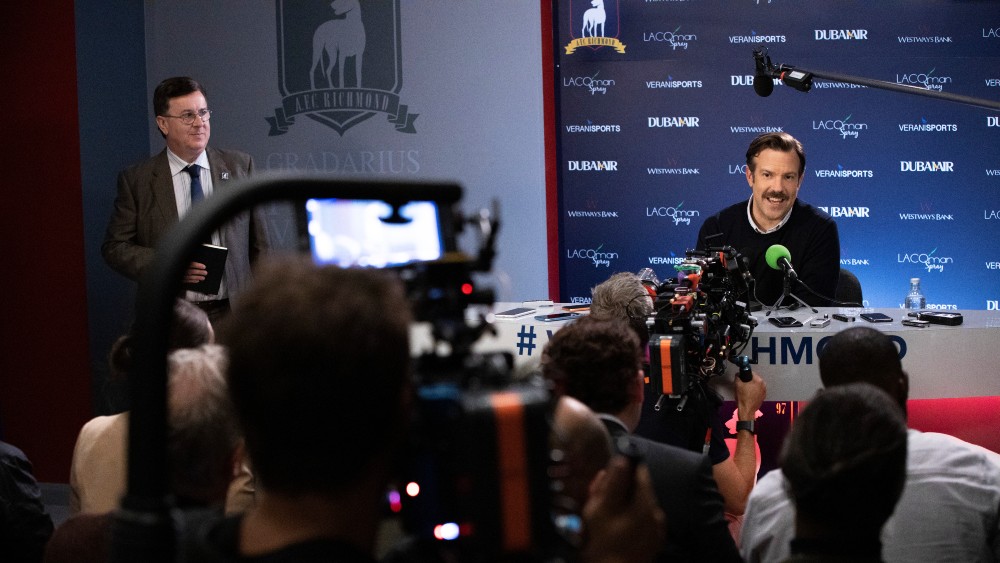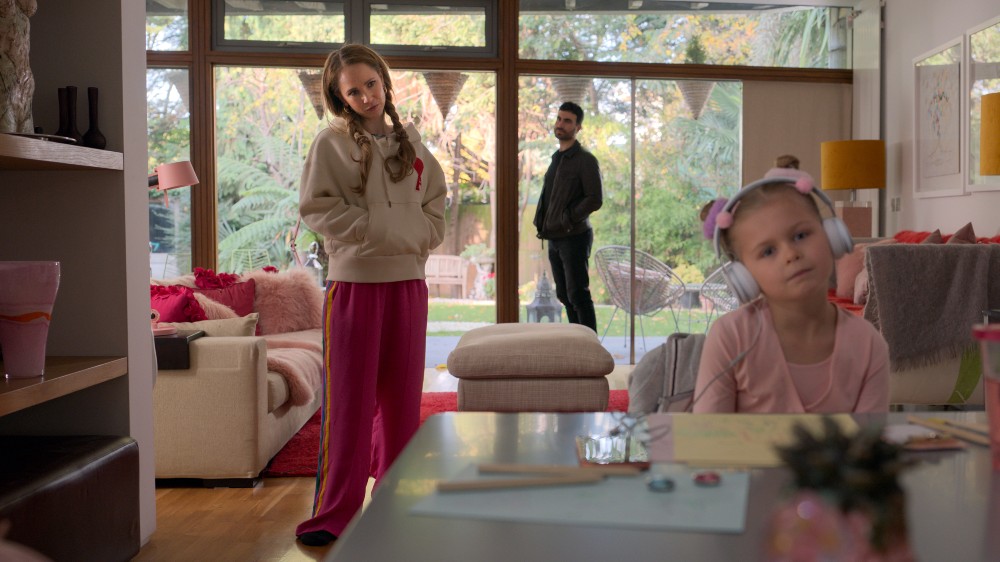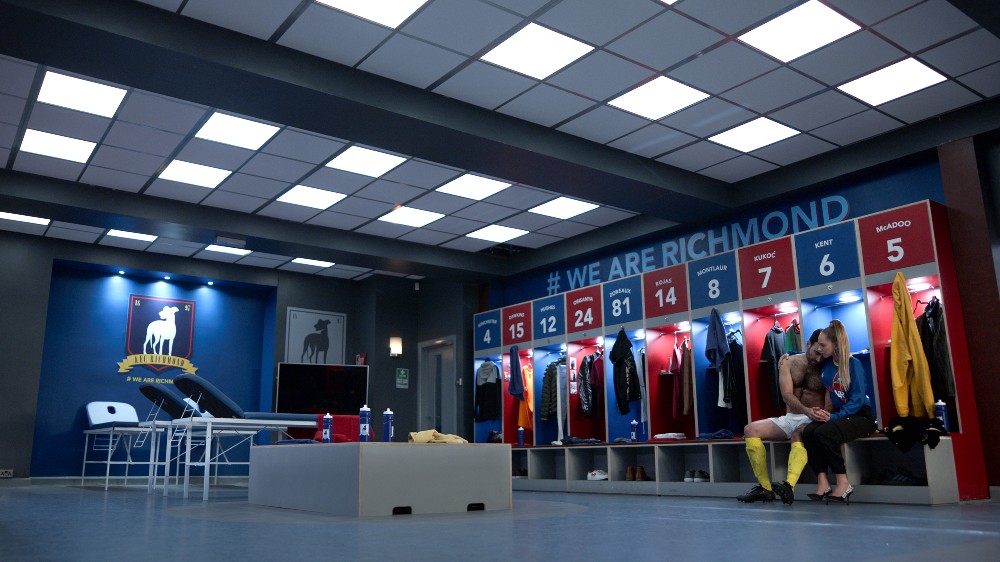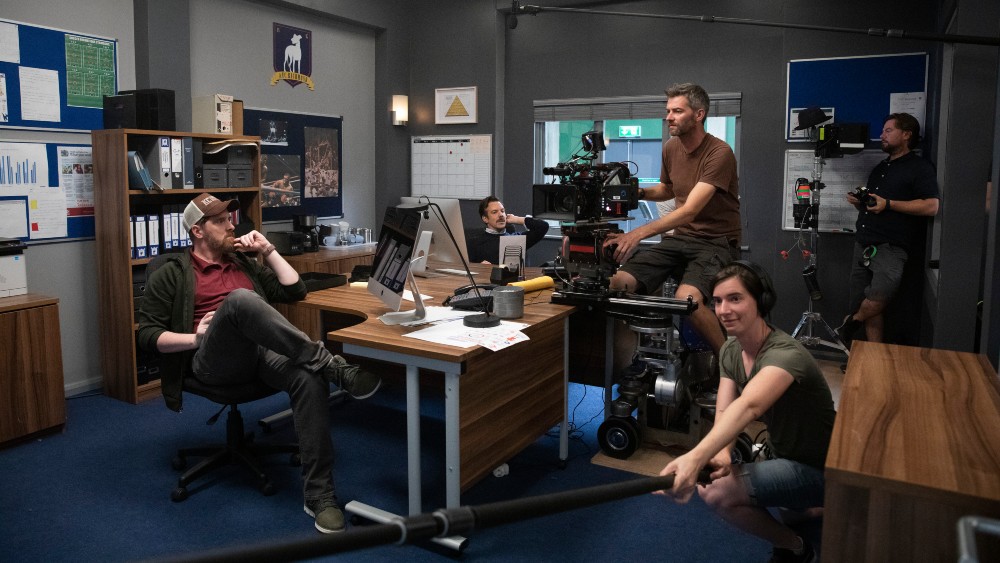
Much like its hero, a misplaced American football coach trying to make his way in a British professional soccer league, Ted Lasso overcame initial skepticism to win at the Golden Globes, the Screen Actors Guild, the Writers Guild, and other awards shows.
As played by Jason Sudekis, one of the creators and writers on the series, Lasso at first glance seems foolishly optimistic, a naïve American hopelessly over his head in a hostile world. But Lasso’s relentlessly upbeat outlook, his refusal to criticize opponents, and his insistence on seeing the best in the people around him are actually exceptional attributes for a coach. They also make for a surprisingly rewarding series, one that can confound the most determined cynic.
Production Designer Paul Cripps has had a long career in episodic television, including Endeavor and The Missing, and he is currently is working on the second season of Ted Lasso. He spoke with Below the Line by phone from Great Britain.

Below the Line: When did you start on the project?
Paul Cripps: First, I did an online call with Jason and [Producer] Bill [Lawrence], which was fun because I hadn’t really done interviews like that in a long time. I’m obviously a big football fan, and I get that world, but I worked quite a bit in live TV when I first started in the industry, which was Jason’s background as well. So I think that may have helped build a bit of a connection.
I met with Bill and his partner when they came over to location hunt. We went around trying to find a place to embed the show. We stopped at Richmond on the way back to the airport, and they really fell in love with it. Jason did too when he came over for a reccie.
BTL: What were they looking for in a location?
Cripps: They wanted to create the world of a football club, not a top-of-the-range one, but kind of a middling, local football club. This is not really a comedy about football, but about characters. A fish-out-of-water story. That’s what I connected with — I loved the scripts, the writing is brilliant. Rather than a parody of a football club, the characters bring the comedy to the show, so they wanted something as real as possible as a backdrop.
BTL: How much prep time did you have?
Cripps: I think about 12 weeks to build actually quite a few sets. The producers were still writing, and they came over here very rarely. So a lot of stuff was done via video call, emailing designs.
We didn’t have a director or DoP until very late, so we were on our own, making decisions at the start which we were a bit worried about. It was nerve-wracking to create a world without anybody there to walk around in it.
BTL: You had to design the sets without input from the cinematographer?
Cripps: We had two [DoPs], David Rom and John Sorapure. I think I scared David a little bit because I created the whole training center before he arrived.
We had so many sets to build, and very little studio space, so I decided that we couldn’t afford to have windows. We used the idea that the training center was built under the stands of the stadium. There wouldn’t be windows as such, the lighting would all be from the inherent fixtures in the building. So one of the principle details of that space is the ceiling. I wanted it to kind of feel a little like All the President’s Men, where you can see the ceiling lights.
I also liked the idea that this space was completely flexible. I felt the writing was a little bit like The West Wing, with a lot of conversations on the move, a lot of walking and talking. I wanted to create a set where you could walk into and out of different rooms without having to cut the scene. The whole of the training center is a composite set, so you can move from one room to another. They’re all linked, as a cameraman you can move through these spaces and go 360, all lit by building lights.
I did give them a few difficulties, but once they got to work and saw that they would be able to shoot low shots and see the ceiling, and to move through rooms, they really got on board. It was a bit of a gamble but I’m experienced in terms of sort of knowing what they want. I think it’s good to challenge them as well, you can’t always give them exactly what they want all the time. [laughing]
BTL: So the idea of long tracking shots filled with dialogue affected your design?
Cripps: It’s not a show about football, it’s a show about people meeting in corridors having discussions, or going into an office, or someone arriving somewhere. It felt like a lot of those scenes were people connecting in different spaces. I thought it would be lovely to have interconnecting sets, so they could go from one to the other.
And you can see people through windows and doors. When you’re in the locker room, you can see into Ted’s office, and Ted can watch the players through his windows. He can see across to the kit room and Nathan [Nick Mohammed], he can look behind into the gym and see the guys working out. The windows and doors add depth to the set because now you’ve got frames within frames.
In The Office, people used to look at each other across desks. You can see what people are doing and what’s going on in their minds just from a look across. I thought that was interesting, it’s a way to add to the characters’ thoughts.
BTL: The connection, the empathy between characters really drives the show.
Cripps: And the dressing room is kind of the hub of all that because it’s where the players are. Ted has his office, so there’s a little division between them. He’s the boss but he’s trying not to be; he wants to be one of those open-door-type bosses. I thought the interplay of characters is vital, so that’s why instead of separate offices, I tried to have it all connected.
BTL: How closely does your locker room resemble a professional team’s locker room?
Cripps: I did base it on several Premier League dressing rooms, one of the main ones being Leicester City. They have slogans in the locker room and all that stuff. It’s a very lowly club, but two years ago they won the Premier League. Nobody believed they could do it, it was kind of a Moneyball thing.
I was trying to build this idea of it’s a team, but a struggling one. There is a real base of love for this club, with fans in the pub as well. It’s tying all those things together so you feel that when Ted comes into this, he sees there is something about this club that needs to be kind of lifted.
We also had a specific problem in that we were going to film the stadium at Crystal Palace, whose colors are red and blue, [including] the seats and a lot of the stands. I took that red and blue to help make the identity of our own team, a kind of exercise in branding.
BTL: What was the ratio of sets to locations?
Cripps: I would say 60 percent sets, for instance everything in the Richmond training center and offices. The pub interior was a set. We were originally going to shoot in the actual pub on Richmond Green, but because of scheduling we could only use the exterior. We did an almost exact recreation of the actual pub. I found out that for the broadcast of the final show, a lot of people booked the pub to watch it there that night.
Ted’s apartment started as a location in the pilot, but then we built a set for that as well, and this year we built a few more sets. So the show is quite set-based.
BTL: How much time did you have for each episode?
Cripps: It’s about 7 days. We shoot in blocks of two, so I think it’s 14 days for a block of two. So it’s really fast-paced. Some of it is two-camera, some of it is single-camera, and they want to allow time for ad libbing. Jason will give 20 different versions of a line and see the reactions from the other characters. They started to do that as well and started buying into his way of doing it.
BTL: Did you rely on visual effects for the games?
Cripps: We intended to shoot on a real pitch in a real stadium, but football clubs are so precious about their pitches. I mean we couldn’t even put a camera on them. In the end we created one and ringed it with a low green wall, effectively the height of the LED sponsor ads that run there.
Then Kip Kroeger and his post team created a 3D stadium based on Selhurst Park, the Crystal Palace stadium. They did crowd replication shots and used digital dummies. So a lot of the football scenes are actually CGI-enhanced.
BTL: What changed for the second season?
Cripps: We’ve obviously been affected by Covid. Because of the pandemic, we took over a small studio and turned it into a kind of bubble. We now have six stages where we only had three for the first season. We’ve expanded a few of the sets and built some new ones.
BTL: Has Covid made your job more difficult?
Cripps: It has, but more in terms of working things out beforehand. We’ve had to do a lot of head scratching. We set up one-way systems in the studio, people come in one way and go out another. We have a rigorous testing process, we’re all tested a few times a week. The actors on set have been wearing masks and these plastic screens right up until the point we film. We also involve social distancing in the scenes, which has been tricky but it’s been okay. Outside work we’ve tried to keep to a protocol of not mixing with people.
Obviously, the sets weren’t built with Covid in mind. I have expanded a couple of the sets because the rooms were so small, so there’s been a little bit of that. I expanded the pub a bit because I was worried about the number of extras we had in there. But overall it’s affected the prep more than the shooting.
BTL: One of the strategies that makes Ted Lasso so memorable is how the writers set up characters and then undermine them, expose all the insecurities they try to hide from the world.
Cripps: I think the essence of the show is you can’t just take people at face value. You can’t underestimate them, write them off as one thing, because people are complicated. The general tenor of the series is you have to be curious about people, you have to find out what is at the heart of why they do things. I think empathy is something that’s often missed in series because they’re all about protagonists trying to overcome problems. This show is accepting that maybe people do have problems, and you have to find a way to work with that. Even if you don’t like them you can maybe understand where they’re coming from and why they’re being like that.
BTL: How involved is Jason Sudekis on a day-to-day level?
Cripps: I basically WhatsApp him every day, checking if he’s okay, is this what he meant by this in the script, what does he think of this. He’s very involved. He’s got a lot to do, he’s in a lot of the scenes, and he’s also writing, so he’s mega-busy. But he’s really embracing of the whole team. He’s not afraid to get involved, he’s pretty open, and you can ask him anything. He’s great to work with as far as I’m concerned.
Ted Lasso can be watched via streaming on Apple TV+. All photos courtesy of Apple.








